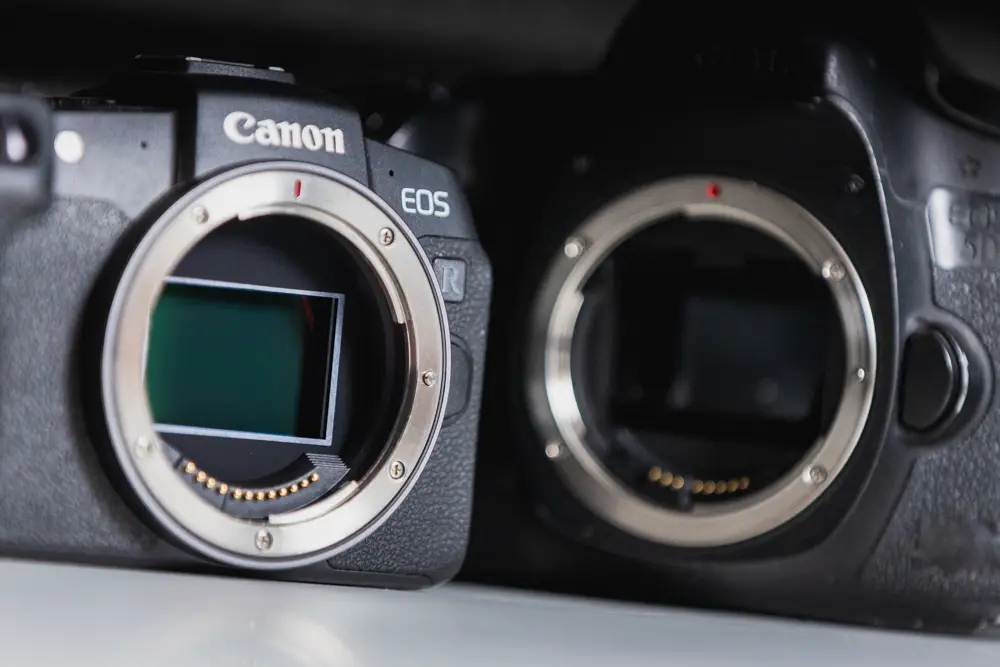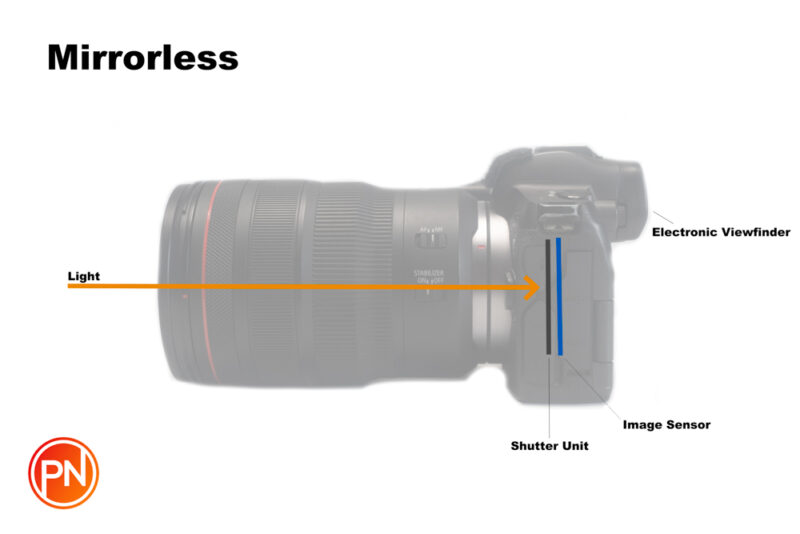Digital photography has come a long way. From film to compact cameras to digital SLRs to smartphones to the latest mirrorless cameras, camera technology keeps surprising us.
The newest innovation, the mirrorless camera, was first introduced commercially in 2008. Since then, it is steadily dominating the market. No wonder many photographers —beginners, lovers, and professionals alike—switch to them.
Are you thinking of getting a mirrorless camera? Do you want to settle about whether it’s the right type for you or not? Look no further. This article will help you solve all your questions about them. Hopefully, it’ll help you understand how to become a better photographer and grow creatively and professionally with them.
So, if you’re wondering about buying a mirrorless camera or just want to know more about them, keep reading.
- What is a Mirrorless Camera?
- How Do Mirrorless Cameras Work?
- Differences Between Mirrorless and DSLRs?
- An Unfair Comparison: Mirrorless vs Smartphones
- Choosing the Right Mirrorless
- Recommendations for Beginners
- FAQs
What Is A Mirrorless Camera?
A mirrorless camera is a digital camera that captures images without using a reflex mirror.
Unlike traditional Digital SLR cameras, mirrorless cameras do not have a reflex mirror that reflects light from the lens into the viewfinder. Instead, they rely on an electronic viewfinder (EVF) or the primary image sensor to display what will be captured by the camera.
How Do Mirrorless Cameras Work?
When you take a photo with a mirrorless camera, the image sensor captures the light and converts it into an electrical signal. A display panel projects the signal on the back of the camera. The camera will capture the image you see on the panel.
Here is an example. Let’s say you want to take a shot of a cat in the streets. It is late at night, and the street lights are all the lights that you have available. With a DSLR, you would have to take the shots and only then see if the cat is captured correctly.
Now, with a mirrorless camera, you look through the digital viewfinder or the LCD screen. You adjust the settings accordingly. The viewfinder (or the screen) adjusts accordingly. You click. You are sure that what you saw has been captured.
What Are The Differences Between Mirrorless And Digital SLR Cameras?
The future is here. Every year, cameras without a mirror system gain more share in the market. Their system is already quite advanced, and for many, they will eventually replace DSLR. Although most photographers seem to make the switch happily, there are a lot of Digital SLR lovers as well. And since most camera producers still produce DSLR cameras, it is essential to know the differences between them. Let’s compare them.
Viewfinder
Think of a DSLR’s optical viewfinder as you are looking through a window.
The light passes through the lens. It hits the mirror. It is then reflected through a prism that flips around so you can see it with your eyes. You see the light as the camera sees it.
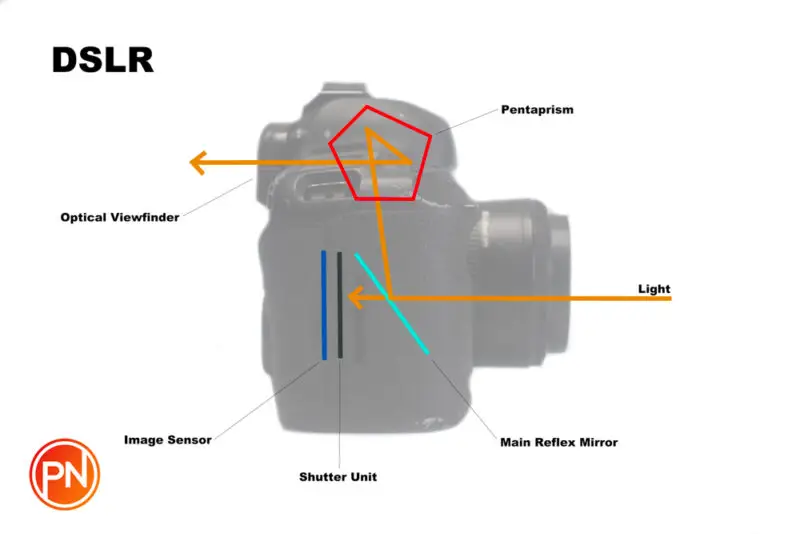
On the other hand, a mirrorless camera is like watching TV.
You don’t get to see what the camera is seeing optically. But you get to see it digitally. Light comes in. It passes right through the lens onto the center. Then the electronic viewfinder will show you exactly what it is seeing.
In the past, you had a sharper and clearer view with an optical viewfinder. The technology progressed enough that an electronic viewfinder is equally sharp and clear.
The digital viewfinder can help you with the focus function as well. In many mirrorless cameras, you can see in real-time if your subject is in focus or not. This way, you can take the shot confidently that what you wanted to capture is captured.
Want to learn more? Read our Ultimate Guide to Viewfinders.
Weight
Imagine carrying the camera all day long. How would it feel after some hours? How about some days?
It is not unusual for professional travel photographers to downgrade their equipment simply because of weight. It becomes essential when considering additional weight such as extra lenses, batteries, camera bags, etc. You want to get the best shots, but how many would you get if the shooting was no longer pleasurable?
No need to be a professional to consider weight, though. Smartphone cameras are so handy that many would sacrifice getting their cameras along their walks or trails. Wouldn’t it be great to carry your lightweight professional camera with you? Well, it is possible.
For example, the Nikon D850—a full-frame DSLR camera—weighs around 915 grams. With almost the same specs, Nikon Z7 weighs 675 grams. That is more than a 25% difference.
Don’t get me wrong. Digital SLR cameras can also be small and light. But if you compare them to mirrorless cameras with the same sensor size, mirrorless usually comes on top.
Size
Guess who won that debate. Since mirrorless cameras don’t have a mirror box, mirrorless cameras are generally more compact. It comes in handy, especially for street photography, where people typically don’t enjoy being photoshoot. A small camera can take the stress away.
Mirrorless cameras are more practical and compact. The compactness could be a drawback for those with big arms or who would not want to compromise on button comfort. Still, most models come with an approachable button layout.
Sensor size plays its role. A full-frame camera is bigger than one with an APS C sensor.
Auto-Focus
One of the major differences is that mirrorless cameras can employ only one autofocus system, whereas DSLRs require two.
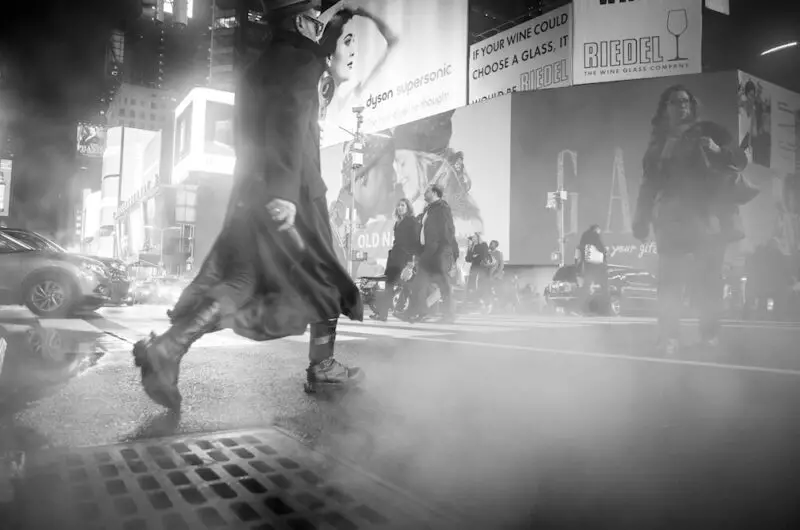
In mirrorless cameras, phase detection is used for Auto-Focus. They can focus more accurately and quickly than contrast detection, which most point-and-shoot cameras use.
Mirrorless has caught up with DSLRs in terms of autofocus speed and even surpassed them for frame coverage and tracking capabilities. No wonder they are now widely used for fast-moving sports and action photography that once demanded a DSLR.
For example, the Canon Eos R5, a full-frame mirrorless camera, has an outstanding autofocus performance. Budget mirrorless cameras like the Panasonic Lumix G100 or the Sony A6000 come with a great system (and video features worth noting)
Speed/Continuous Shooting
Regarding speed, mirrorless cameras have a significant advantage over DSLRs. They can shoot at high speeds with very little lag time between shots. The same goes for continuous shooting (or burst shooting), which is essential for action shots.
For example, the new full-frame Fujifilm X-H2S can capture 40 frames per second. Nikon fans will stick to the Nikon z system, which offers a continuous shooting speed of 4.5 fps.
Note that mirrorless cameras do not need to move the mirror out of the way to take a picture. They can take pictures much faster than a DSLR, making burst shooting discreet and fun.
The electronic shutter is silent compared to the mechanical shutter. I enjoy this feature for spontaneous portrait photography or when the shutter noise can affect the object I am shooting.
Imagine you are photo shooting a magpie grasping a nut. Let’s say that the whole action takes around five seconds. With the continuous shooting feature on, you can shoot 70 to 100 images.
It is important to note that the speed of mirrorless cameras is not just limited to the shooting speed. Mirrorless cameras also have shorter shutter lag and faster start-up times than DSLRs.
Generally, with a mirrorless camera, you will need less time from the start to focus on shooting the magpie’s beak.
Video Quality
In general, mirrorless models are great video cameras.
Mirrorless cameras can record high-quality video with minimal rolling shutter distortion.
Rolling shutter distortion is when the bottom of the frame is recorded before the top of the frame. It causes objects to appear to be moving faster than they are or to be seen as distorted.
Alternatively, digital SLR cameras, have a mirror that needs to move out of the way when taking a picture. This mirror can cause rolling shutter distortion when recording video.
Because they do not have a mirror, distortion is minimized in mirrorless video mode.
The video quality of mirrorless has improved to the point where professional video shooters and filmmakers now love using them.
Panasonic GH-series and other series have features that allow them to record slow-motion video. Slow-motion video is a type of video that is played back at a slower speed than it was recorded.
You can record an action video and play it back in slow motion.
Battery Life
One of the most significant disadvantages of mirrorless cameras is that they have shorter battery life than digital SLRs. But why do mirrorless cameras have worse battery life?
Mirrorless electronic viewfinders drain the battery faster than optical viewfinders (OVF).
Another factor contributing to mirrorless cameras’ shorter battery life is that they have more features than DSLRs. These features, such as wifi and touch screens, drain the battery more quickly.
In-body image stabilization plays a role in battery life as well. Its effect is relatively minimal, though.
On many occasions, having extra batteries with you will save you some trouble. Make sure to switch off the camera whenever possible and not let the batteries drain completely. Watch the following video for more tips:
Price
When mirrorless cameras first came onto the market, they were much more expensive than Digital SLR cameras. Mirrorless cameras were a new technology and were not as widely available as DSLRs.
But the table is turning. An entry-level model like the Sony A-series or the Nikon Z-series costs less than $1000 (body only).
As expected, the best mirrorless cameras are pretty expensive. But what about lens price?
Lenses for mirrorless cameras can be more expensive compared to DSLR ones. Many DSLR native lenses are on the market, and not as many lenses are available for mirrorless cameras.
Full Frame And APS-C Sensor
The APS-C sensor is found in most entry-level and mid-range DSLRs and many mirrorless or compact system cameras (CSCs).
Cameras with this sensor size produce images with a narrower view angle. That’s because they capture a smaller scene section than a full-frame camera does.
In optical viewfinders, you’ll find that scenes look brighter in a full-frame than in an APS-C one. That’s because a full-frame camera has a larger mirror than a crop-sensor camera.
In digital viewfinders, full-frame mirrorless cameras and APS-C sensors offer the same size and high resolution. One of the best full-frame cameras, the Canon Eos R3 produces a smooth, lifelike display.
Features
Mirrorless cameras have a lot of advanced features that make them attractive to photographers and videographers. Some of these features include:
Interchangeable Lenses
Just like DSLRs, mirrorless cameras have interchangeable lenses.
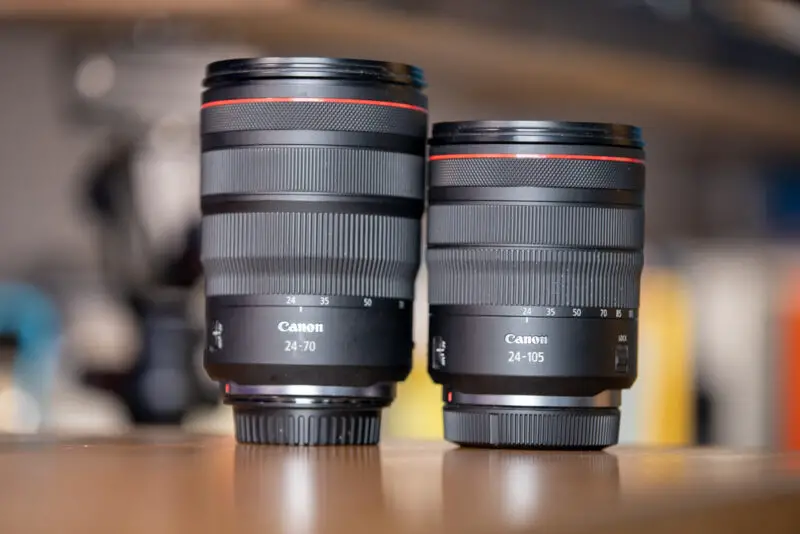
You can use different lenses for different situations. For example, you could use a wide-angle lens for landscape photography or a telephoto lens for wildlife photography. If you previously owned a DSLR and are thinking of going mirrorless, your lenses will not be a problem. You will need an adapter and can use all the lenses you want. Adapters range from $50 to $150.
Articulating Screen
Mirrorless cameras have an articulating screen. For example, you could move the screen to the side so you can see it when taking a picture from a low angle. DSLRs have a fixed screen, meaning they cannot be moved to different positions.
Built-In Flash
Mirrorless models have a built-in flash. You do not need to carry a separate flash unit with you when you are taking pictures. DSLRs usually do not have a built-in flash and require a separate flash unit.
Wifi And Bluetooth
Mirrorless cameras have wifi and Bluetooth. Connect the camera to your computer or smartphone to transfer pictures or videos. DSLRs usually do not have Wifi or Bluetooth.
You may be interested in a microphone input, a headphone jack, twin card slots, or a full weather sealing. Keep that in mind when comparing.
An Unfair Comparison: Mirrorless Cameras Versus Smartphones
While comparing two different devices is not fair, many wonder whether to stick to their smartphone for taking shots or buy a camera.
It all comes down to preference.
For example, portrait photography often uses 24-50mm lenses. You will certainly be able to create exciting portrait compositions with a camera. Still, your smartphone camera could also take good shots.
Do you want to have more control over your pictures? Do you want to be able to change lenses and play around with the composition? How much attention to detail do you want to bring to your photography?
Choosing The Right Mirrorless For Your Photography And Video Needs
Now that you know more about mirrorless cameras, it’s time to choose the right one for your needs. There are many different mirrorless cameras on the market, so it’s essential to do your research before making a purchase. A few things to note when choosing a mirrorless camera:
Mirrorless Cameras Features #1: Sensor Size
The sensor size is one of the most critical parts of any camera. Mirrorless cameras come with either full-frame, APS-C sensors, or micro four-thirds. Full-frame sensors are larger and offer better image quality but are more expensive. APS-C sensors are smaller and less costly, yet they provide great image quality. Micro four-thirds cameras are the smallest and thus the most compact cameras.
Mirrorless Cameras Features #2: Lens Mount
The lens mount is the part of the camera that connects to the lenses. Mirrorless cameras use either EF or EFS mounts. EF mounts are compatible with all Canon lenses, while EFS mounts are only compatible with specific ones.
Mirrorless Cameras Features #3: Autofocus
Autofocus is a feature that allows the camera to focus automatically. Mirrorless cameras come with either contrast-detect or phase-detect autofocus. Contrast-detect autofocus is slower but more accurate, while phase-detect autofocus is faster but less accurate.
Mirrorless Cameras Features #4: Video
Choose a model that fits video needs if you plan on shooting video with your mirrorless camera. Most models offer 1080p resolution, a 60fps frame rate, and built-in-body image stabilization. Look for additional features such as unlimited recording times, the live stream video quality of 4K or 6K, customizable video, pro-spec video options, etc.
Recommendations For Beginners
If you can’t decide whether or not to buy a mirrorless camera, here are a few tips to help you settle on a decision:
Buy used – Mirrorless cameras are often cheaper when bought used. It’ll save you money if you’re on a budget. This discussion may help you avoid mistakes.
Spend less – If you are a beginner, do not spend much money on the camera’s body. The technology has advanced, so you can’t go wrong with any brand.
Try before you buy – Most camera stores will let you test the cameras before buying them—a great way to see if they’re right for you. Go in the store with your features checklist and try them out.
Rent a mirrorless camera – Have you considered renting one instead? This way, you can try out the camera for a short time and see if it’s something you’ll use regularly.
FAQs
Why Do Photographers Use Mirrorless Cameras?
Mirrorless models are faster yet wiser, lighter yet smaller. They provide better video quality, unique features, and great value for money.
What Lenses Are Available For Mirrorless Cameras?
As mirrorless cameras have only been around for a few years, the range of lenses available is not as comprehensive as for DSLR cameras. But this is changing. There are now many different types of lenses available for mirrorless cameras.
There is always the option of an adapter, though. You can use most DLSR lenses in mirrorless cameras simply by using an adapter. Some of the most popular mirrorless camera lenses include:
Standard prime lens – These lenses are great for general-purpose photography and have a focal length of around 50mm.
Wide-angle lens – These lenses have a focal length of around 24mm and are great for landscape or architectural photography.
Telephoto lens – These lenses have a focal length of around 70-200mm and are great for wildlife or sports photography.
Macro lens – These lenses have a focal length of around 100mm and are great for close-up photography.
What Is The Disadvantage Of Mirrorless Cameras?
They have a shorter battery life because of the features they provide. There are not as many lenses in the market as for a DSLR camera —but expect that to change. The electronic viewfinder can be disturbing to the eye in low-light environments. They may be more expensive.
Which One Is Better, Mirrorless Or DSLR?
Mirrorless cameras are faster, smarter, and lighter. They provide superior video quality and innovative features. In the last years, they have become less expensive as well. On the other hand, DSLR cameras offer more lens options and have bigger battery life.
Do Mirrorless Cameras Need A Flash?
Mirrorless cameras do not need a flash, but they can use one if you desire. The main advantage of using a flash with a mirrorless camera is that it can help to reduce red-eye.
How Long Do Mirrorless Cameras Last?
Mirrorless cameras should last you several years, as long as you take care of them. The average mirrorless camera has a lifespan of around 50,000 shutter actuations. If you take an average of 200 photos per week, your mirrorless camera should last for over 20 years.
Is DSLR Still Worth Buying?
DSLR cameras are still worth buying for many reasons. They offer a wide range of lenses, and longer battery life and they may also cost less than mirrorless cameras. DSLR cameras are a great option for beginner and professional photographers alike. So if you’re looking to get into photography, don’t write off DSLRs just yet.
Conclusion
Mirrorless models are an excellent option for both amateur and professional photographers.
Hopefully, this article has helped you better understand mirrorless cameras and what they offer. If you’re thinking about switching from DSLR to mirrorless, or are simply curious about cameras, research and find the best model for your needs.
Thanks for reading. Feel free to share it with your friends or leave a comment below.
Happy shooting!
